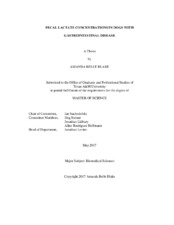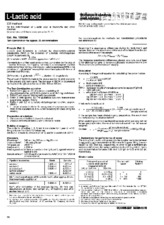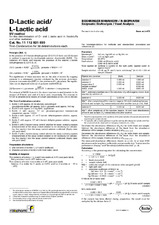| dc.description.abstract | Lactate concentrations in the blood or serum are currently used as prognostic indicators of certain diseases in human and veterinary medicine. Lactate concentrations in the feces are of interest because it is a metabolic product of fermentation by the intestinal microbiota. However, no cost effective method to quantify the D- and L-isoforms of lactate in canine feces is currently available. Therefore, the main objectives of this study were to modify and validate an enzymatic assay for the quantification of D-, L-, and total lactate in canine feces, and to characterize fecal lactate concentrations and bacterial abundances in healthy dogs and dogs with gastrointestinal diseases.
The enzymatic assay was validated with surplus homogenized fecal samples by determination of dilutional parallelism, spiking recovery, and intra- and inter-assay variability. Fecal samples were collected from healthy dogs (n=34), dogs with acute hemorrhagic diarrhea (AHD; n=20), dogs with chronic enteropathy (CE; n=15), and dogs with exocrine pancreatic insufficiency (EPI; n=34). Fecal lactate was measured with the new enzymatic assay and 11 bacterial groups were quantified with qPCR.
A canine fecal lactate reference interval was established from 34 healthy dogs and was 0.7-1.4 mM, 0.3-6.0 mM, and 1.0-7.0 mM for D-, L-, and total lactate, respectively. The assay for measurement of D-, L-, and total lactate in canine fecal samples was linear, accurate, precise, and reproducible. Significant increases in fecal lactate concentrations were observed in dogs with acute hemorrhagic diarrhea, dogs with chronic enteropathy (D-lactate only), and dogs with exocrine pancreatic insufficiency. Blautia spp. and Clostridium hiranonis abundances were decreased in all diseased groups of dogs compared to healthy dogs. Dogs with EPI that were receiving enzyme replacement therapy had an increased abundance of Lactobacillus spp. and Bifidobacterium spp., and all dogs with EPI had an increased Dysbiosis Index compared to healthy dogs.
In conclusion, further studies are necessary to determine the clinical utility of lactate quantification in canine feces. Though lactate by itself may not be a good indicator of dysbiosis, bacterial metabolites together with bacterial abundances are promising targets for further elucidating the role of the microbiota in health and disease. | en |




